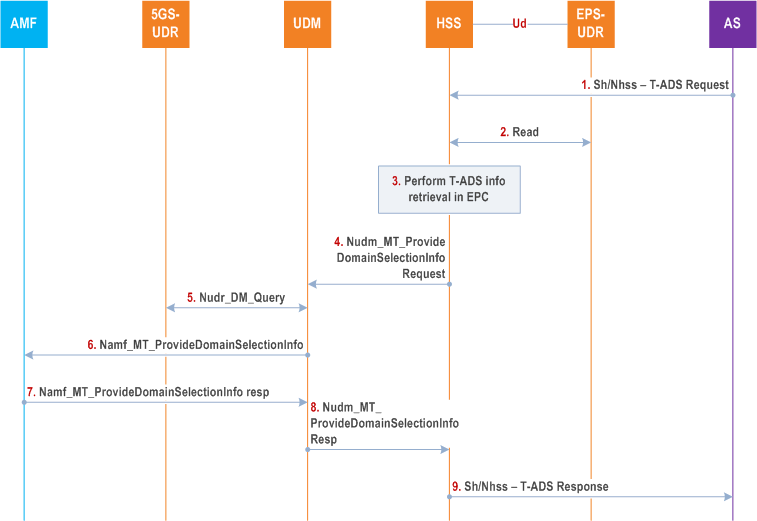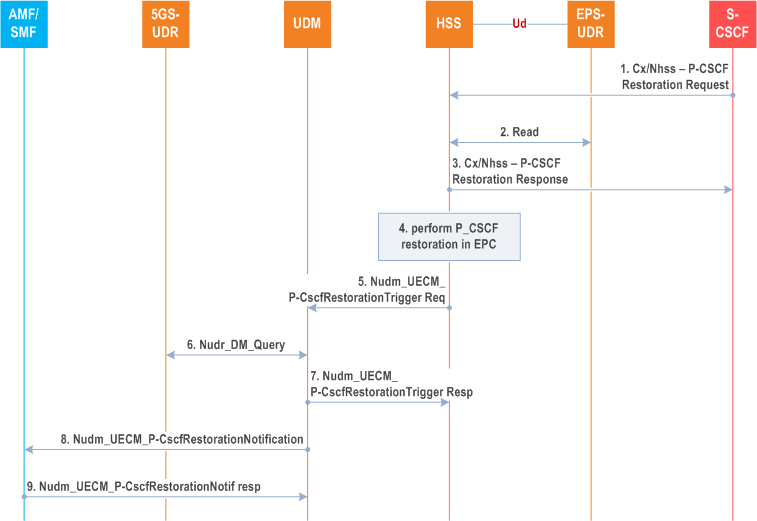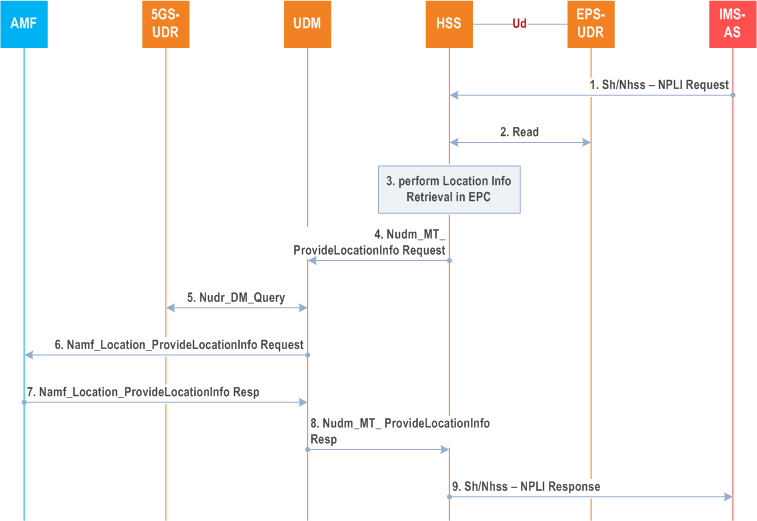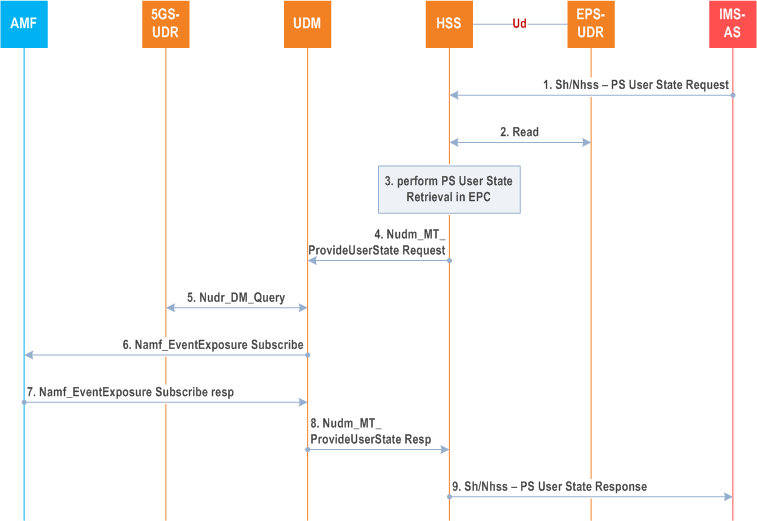Content for TS 23.632 Word version: 18.5.0
5.4 Scenarios of Interworking with IMS
5.4.0 General
5.4.1 T-ADS
5.4.2 P-CSCF Restoration
5.4.3 Network Provided Location Information Request
5.4.4 User State Retrieval
...
...
5.4 Scenarios of Interworking with IMS p. 21
5.4.0 General |R18| p. 21
The following clauses assume that the HSS (and EPS-UDR) supports IMS procedures and EPS procedures. However, in EPS-less deployments where the HSS supports only IMS procedures, the EPS-UDR may store only IMS profile information and IMPI-IMSI associations, but no EPS-Profile information. In such deployments the HSS can retrieve the user's IMSI associated to the given IMPI from the EPS-UDR and can skip the steps involving EPC procedures.
5.4.1 T-ADS p. 21
Figure 5.4.1-1 shows the scenario where the HSS receives a T-ADS request from the AS for a subscriber who has a 5GC subscription.

Step 1.
The HSS receives a T-ADS request from the AS. The request includes the user's IMPU or MSISDN and optionally the user's IMPI.
Step 2.
If the EPS-UDR is used, the HSS reads subscription data from the EPS-UDR. The HSS, retrieves the user's IMSI associated with the user's identifiers received in step 1. The subscription data may contain an indication that the user has a 5GC subscription.
Step 3.
The HSS performs T-ADS info retrieval in the EPC. This may include contacting the MME and/or SGSN.
Step 4.
If the HSS detects in step 2 that the user has a 5GC subscription and unless the user is known not to be registered in 5GC (e.g. in case the user is registered in EPC and the HPLMN is working in single registration mode with N26), the HSS uses the Nudm_MT_ProvideDomainSelection service operation to retrieve T-ADS information from the UDM. The HSS includes the user's IMSI associated with the user's identifiers received in step 1 as the SUPI in this request.
Step 5.
The UDM reads data from the 5GS-UDR to see whether the registered AMF(s) support IMS voice over PS.
Step 6-7.
If support/non-support of IMS voice is not homogeneous for the User in the AMF for 3GPP access, the UDM retrieves domain selection information from the AMF.
Step 8.
The UDM provides the 5G domain selection info to the HSS.
Step 9.
The HSS combines the 5G domain selection info with the EPS domain selection info from step 3 and sends the result to the AS.
5.4.2 P-CSCF Restoration p. 23
Figure 5.4.2-1 shows the scenario where the HSS receives a P-CSCF restoration indication from the S-CSCF for a subscriber who has a 5GC subscription.

Step 1.
The HSS receives a P-CSCF Restoration indication from the S-CSCF. The request includes the user's IMPU and IMPI.
Step 2.
If the EPS-UDR is used, the HSS reads subscription data from the EPS-UDR. The HSS, retrieves the user's IMSI associated with the user's identifiers received in step 1. The subscription data may contain an indication that the user has a 5GC subscription.
Step 3-4.
The HSS acknowledges receipt of the request and performs P-CSCF restoration in the EPC. For details see clause 5.4.2.1 of TS 23.380.
Step 5.
If the HSS detects in step 2 that the user has a 5GC subscription and unless the user is known not to be registered in 5GC (e.g. in case the user is registered in EPC and the HPLMN is working in single registration mode with N26), the HSS uses the Nudm_UECM_P-CscfRestorationTrigger service operation to trigger P-CSCF restoration in 5GC. See also clause 5.8.4 of TS 23.380. The HSS includes the user's IMSI associated with the user's identifiers received in step 1 as the SUPI in this request
Step 6.
The UDM reads data from the 5GS-UDR to see which NFs have subscribed to P-CSCF Restoration Notifications (implicitly during registration).
Step 7.
The UDM acknowledges receipt of Nudm_UECM_PCscfRestorationTrigger to the HSS.
Step 8-9.
The UDM sends a notification to one of the subscribed NFs (either the AMF or the SMF).
5.4.3 Network Provided Location Information Request p. 24
Figure 5.4.3-1 shows the scenario where the HSS receives a Location Information retrieval request from the IMS-AS for a subscriber who has a 5GC subscription.

Step 1.
The HSS receives a Location Information retrieval request (requested nodes includes AMF) from the IMS-AS.
Step 2.
The HSS reads subscription data from the EPS-UDR.
Step 3.
The HSS performs Location Information Retrieval from other nodes if so requested. This may include contacting the MME and/or SGSN.
Step 4.
If the HSS detects in step 2 that the user has a 5GC subscription and unless the user is known not to be registered in 5GC, the HSS uses the Nudm_MT_ProvideLocationInfo service operation to retrieve 5GS Location Information. The service request includes indicators for Current Location, Serving Node Indication, Local Time Zone Indication, and RAT-Type requested as has been received in step 1.
Step 5.
The UDM reads data from the 5GS-UDR to get the AMF and SMSF for 3GPP Access Registration Information. If the Serving Node Indication was received in step 4, steps 6-7 shall be skipped.
Step 6-7.
The UDM retrieves location information from the AMF (for 3GPP access) by means of the Namf_Location_ProvideLocationInfo service operation .
Step 8.
The UDM provides the 5GS location information info to the HSS.
Step 9.
The HSS provides the requested location information to the IMS-AS.
5.4.4 User State Retrieval p. 25
Figure 5.4.4-1 shows the scenario where the HSS receives a PS User State retrieval request from the IMS-AS for a subscriber who has a 5GC subscription.

Step 1.
The HSS receives a PS User State retrieval request (requested nodes includes AMF) from the IMS-AS.
Step 2.
The HSS reads subscription data from the EPS-UDR.
Step 3.
The HSS performs PS User State Retrieval from other nodes if so requested. This may include contacting the MME and/or SGSN.
Step 4.
If the request includes AMF as requested node and if the HSS detects in step 2 that the user has a 5GC subscription and unless the user is known not to be registered in 5GC, the HSS uses the Nudm_MT_ProvideUserState service operation to retrieve the 5GS User State. Otherwise, continue with step 9.
Step 5.
The UDM reads data from the 5GS-UDR to get the AMF for 3GPP Access Registration Information.
Step 6-7.
The UDM retrieves the user state from the AMF (for 3GPP access) by means of the Namf_EventExposure Subscribe service operation (one time immediate report requested).
Step 8.
The UDM provides the 5GS PS User State to the HSS.
Step 9.
The HSS provides the requested user state to the IMS-AS.